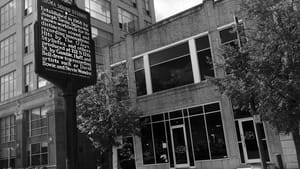Stay in the Loop
BSR publishes on a weekly schedule, with an email newsletter every Wednesday and Thursday morning. There’s no paywall, and subscribing is always free.
Honoring the Philly sound
Champions of Philly’s music legacy fight to save the site of Sigma Sound Studios

On October 21, a bid to preserve the building that once housed Philly’s famed Sigma Sound Studios breezed through the Philadelphia Committee on Historic Designation’s nomination process. It was the first of two meetings that will likely determine the fate of the building, which developers plan to demolish to make way for high-rise luxury condos.
Formerly headquartered at 210-212 North 12th Street, just a few blocks from City Hall, Sigma helped give rise to the sound that came to embody 1970s R&B and disco. The studio was home base for Philadelphia International Records, whose roster included the Delfonics, the Stylistics, Harold Melvin and the Blue Notes, and the renowned MFSB players. David Bowie, Dusty Springfield, the Jacksons, and many other stars sought out Sigma’s sound, making pilgrimages there to record albums. It’s one of the few remaining buildings in the city connected to what’s been called the Golden Era of Philly music, roughly a three-decade stretch from the 1950s through the 1970s.
Didn’t need convincing
The nomination for historic designation quickly passed by unanimous consent. “I didn’t need convincing about Sigma because of what I already knew,” committee chair Emily Cooperman said during the hearing. “It gets me in my Philly heart is all I can say.” With the committee’s recommendation, Sigma’s case will now be heard by the full historical commission, which will make the final decision.
The move to preserve Sigma was spearheaded in large part by Max Ochester, owner of Brewerytown Beats Records and founder of the nonprofit Philly Sound Archive. A music collector with an encyclopedic knowledge of Philly soul, he assembled a number of people together in support of the cause, including former Sigma employees, music industry veterans, and academics. The Preservation Alliance of Greater Philadelphia submitted the proposal.
Really historic
“There’s a perception that the kinds of buildings that most deserve to be preserved are much older,” Preservation Alliance director of advocacy Patrick Grossi told me. “The most exciting part of [Sigma’s] story is the late ’60s and 1970s, which is not that long ago, so that sometimes will raise an eyebrow—‘is this really historic?’ I think it’s our job as preservationists to say undeniably yes, that recent history is history and helps us to tell a story about Philadelphia.”
Designed by architect Charles Oelschlager and constructed around 1935, the building became the cornerstone of a bustling media district in the mid-20th century. Beginning in the late 1950s, it was home to the Reco-Art studio, where a number of hits for Philly-based labels such as Cameo-Parkway were recorded. “She Loves You,” the first number-one Beatles record in the United States, was mastered there in 1963 before being released on the local Swan label.
In 1968, Joe Tarsia, an audio engineer who cut his teeth with Cameo-Parkway, purchased the Reco-Art studio. He rechristened it Sigma and converted it into an innovative state-of-the-art studio. Two Cameo-Parkway songwriting veterans, Kenny Gamble and Leon Huff, had just launched their own label, Philadelphia International Records. Along with producer/arranger Thom Bell, they turned to Sigma for the sound they were looking to capture.
The sound that people wanted
“It was a vibrant facility,” said veteran radio broadcaster and Influence Entertainment CEO Dyana Williams, who remembers being impressed by the large number of gold records hanging on the wall during her first trip to Sigma in the mid-1970s. (All told, close to 175 gold and platinum records were recorded at Sigma.) She recalls spacious rooms that seated entire orchestras, which gave musicians the opportunity to replicate the live experience in the studio. “There was a sound that other people wanted,” she says. “Infectious, melodic, and very rhythmic.”
Toby Seay, the project director of the Drexel University Audio Archives, where the Sigma Sound Studios Collection is housed, echoed this. “We’re talking about these incredibly lush, incredibly large, incredibly complicated productions.” He pointed out that the music recorded there helped give birth to the disco genre. (The disco beat itself is credited to Philly drummer Earl Young and first appears in those recordings.) “You also had small record companies and local Philly bands, and their stories are there as well. And it all happened on a day-to-day basis there.”
A museum for Philly’s music?
Tarsia retired from Sigma in 2003. The building was sold to overseas developers in 2015.
Most of the building is gone now, aside from the façade—stripped and gutted by developers, prepped for replacement with a luxury 10-story condo building.
Although it will take a great deal of effort, supporters are optimistic that the space can be restored and reinvigorated. Ultimately, they hope to transform the Sigma building into an exhibition space or museum that celebrates Philly’s vast musical legacy. “The original building for Motown is a museum in Detroit, Sun Studios in Memphis is a museum,” Seay reasoned. Why not do the same for Sigma and Philly?
If the museum vision comes to fruition, the Drexel University Audio Archives would be well equipped to assist. In December 2014, when the building was sold, Seay and Tarsia went through and collected artifacts, from original blueprints to music stands, that could potentially be reinstated as part of an exhibit and also aid in recreating the space.
But Grossi cautioned that even if the Sigma building is approved to be added to the historical registry, that designation will not determine whether the building becomes a music museum. There are other variables at play, such as zoning considerations, and the building could just as easily become a residential or commercial property. The designation “is really just to create an opportunity for that vision,” he says. “The alternative is that it gets demolished and then redeveloped.”
A very special place
Regardless of what ultimately happens, Williams pointed out that the music will continue to be played, rediscovered, and sampled for generations to come. “It was a magical time,” she reminisced. “There was a certain energy that permeated Sigma Sound Studios. We’re known as the city of brotherly love and sisterly affection, and that energy of our city slogan permeated. As soon as you walked through the door, you knew you were in a very special place.”
Now that it has been formally nominated, Sigma will be considered for historic designation by the full Philadelphia Historical Commission, possibly as soon as its meeting on November 13. (The agenda will be released about a week prior to the meeting.) Members of the public are welcome to attend the online meeting and will be given an opportunity to comment. They may also email the Commission at [email protected] to weigh in on a nomination.
Image description: A black-and-white photo of the exterior of a city building. A historic marker in the foreground is titled “Sigma Sound Studios” and reads “Established in 1968 by Joseph Tarsia, Sigma was known worldwide for its distinctive sound and recording innovations. Hits by the O’Jays, Stylistics, and other produced at 212 N. 12th St. by Gamble, Huff, and Bell drew top recording artists such as David Bowie and Stevie Wonder.”
Sign up for our newsletter
All of the week's new articles, all in one place. Sign up for the free weekly BSR newsletters, and don't miss a conversation.

 Aaron Cohen
Aaron Cohen